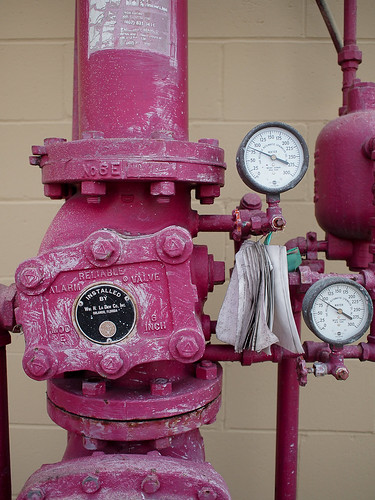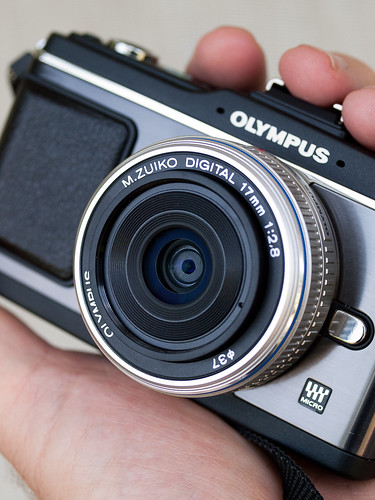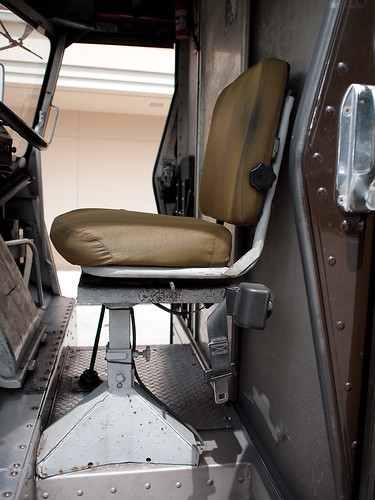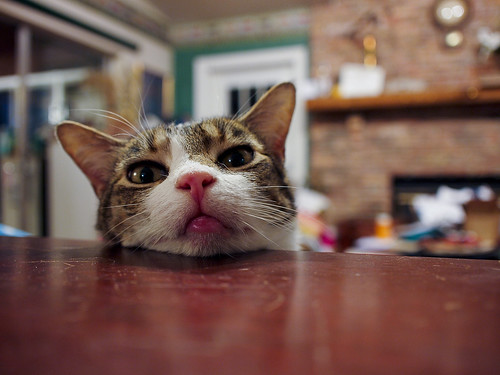How much is camera gear supposed to cost?
Orlando Diary
This isn't a review of camera gear, so much as a personal editorial. I intend to review the M.Zuiko 17mm on Matthew's Reviews in the very near future. For now, I just wanted to write some editorial content about the cost of camera gear, something that might not be appropriate on Matthew's blog.
For personal as well as financial reasons, I've always been something of a cheapskate. I can dress that up by saying I believe in the power of value buying, but it all comes down being "a person who is reluctant to spend money."
And why shouldn't I be reluctant to spend money, especially on today's digital gear? The pace of development is so rapid in digital photography that your new shiny is obsolete even before you purchase it for use. That's because by the time your future piece of gear hits the market, the manufacturers have at least one, and possible two, new generations right behind it, driven by what was learned to manufacture the camera du jour, coupled with advances in the materials that go into a camera body and by changing consumer tastes. With that crucible constantly churning, you'll see product introductions and announcements every six months down at the low end (point-and-shoot up to entry level digital SLRs) to every 12 months for mid-range DSLRs, up to years between announcements for the flagship models.
The real interesting development takes place in the mid-tier models in both the P&S as well as mid-range DSLRs. The price bracket for both overlap considerably, but the price for interesting cameras in both camps extends from roughly $500 up to $1500. Anything less than $500 and you run the risk of purchasing a fashion statement more than a camera in the P&S category, or else somebody's end-of-life dump in the entry-level DSLR category. No, this is a range for cameras that have been introduced or are in the middle of the product life.
This also ignores used gear. I know a lot of people who swear by used gear, since you can find some real bargains. And I know just as many who swear at used gear, for the simple reason that when you buy used (not refurbished), you buy as-is, with no warranty. If it breaks, then you're pretty much on your own getting it repaired. Refurbished, depending on the manufacturer, will usually give you the same warranty as a new item, but at a lower cost to get it off the books. Refurbished items are usually returns from initial owners who bought it, found it they didn't like it for some reason, and returned it within the selling store's return policy. You'll find an awful lot of refurbished gear after Christmas. And you have to be really on the ball to find those refurbished deals.
So I'm talking about gear that is just introduced or is in the middle of its product life cycle that can be purchased just about anywhere at any time, depending on your time, taste, and budget. That covers an awful lot of gear.
I started my "real" photography life buying used. I got my first 35mm camera (Yashica GSN) and my first and last 6x6 camera (Mamiya c330 pro-f) through my dad in the early 1970's. My dad worked for Delta (Atlanta) with a group of draftsmen who were pretty talented artists and photographers. Back then gear was relatively inexpensive in relation to salaries and disposable income. Guys in my dad's group would buy gear, use it for a while, and then trade up or move to something else in photography. Offers to sell the orphans wound up on the group's bulletin board (back when it was cork and covered a large section of one wall). And this gear was lovingly cared for. Both cameras came to me as if new, with not a mark on them. And then there was the added bonus that if anything went wrong, my dad knew who the seller was; it was a tight community and nobody wanted to sell another member a lemon. It was a great place to buy useful gear, especially on a budget.
Unfortunately for me those times have long since passed. I have yet to find a similar market I can trust the way I trusted my dad's group nearly forty years ago. I've been told there are similar markets for used gear out there, but I'm not willing to take the risk. Used gear is expensive enough that I would rather buy new from the manufacturer in order to (1) get the complete warranty, and (2) avoid the possible risk that some internal component's life span has been shortened because it's used, thus increasing the risk that the camera will stop working for me. Regardless of whether I pay to fix it or it's still under warranty, gear that is in repair is gear I'm not using. When you buy new gear you are paying for, in part, the ability to use it for as long as possible. And statistically speaking, for most gear, new gear will work longer than used before requiring servicing or repair.
So we've established a range and a type of gear to purchase. Within that range is a tremendous selection of bodies, lenses, flashes, and other equipment. The next question is "how much?" The answer will vary from person to person, but it basically comes down to how little you need to invest in gear to achieve the greatest amount of enjoyment. Or to put it another way; the best gear to use is the gear you can afford (a variation on the best camera is the one you have with you).
And this is where the M.Zuiko 17mm f/2.8 comes into this story. The M.Zuiko is a reasonably inexpensive pancake prime (MSRP $300; I paid $250 discounted for mine) that is at least a half-stop faster than the M.Zuiko 14-42mm f/3.5-5.6 kit zoom. When attached to the E-P2 it makes the camera's physical size quite diminutive. The only problem with this lens according to its critics is that it isn't as good as the Panasonic 20mm f/1.7; it's not as sharp wide open, it has too much chromatic aberration in the corners, and it's at least a stop-and-a-half slower than the Panasonic. The problem is that the Panasonic is at least a good $100 more expensive than the the Olympus.
And then there's the issue of perceived image quality. First and foremost, it is indeed a slower lens. For the photographer who shoots in low light, that difference can be split in one of two ways; adjust the ISO higher to support a fast-enough shutter and shoot as wide open as possible, or keep the ISO as low as possible and adjust the shutter speed to very slow speeds. In one instance you get a better chance for a sharper but noisier image and the ability to minimize motion blur, while in the other direction you get images with less noise, and in some cases, a lot less noise, but you run the risk of motion blur ruining the shot. Only experience can help you decide.
I can't argue with the lens speed. I certainly could use the speed if I were shooting predominately low-light with the E-P2. But that's not where I'm at right now with my use of the E-P2. I live in Florida, which has lots of sun, even when it's cloudy. I'm not into visiting dark bars (having left that scene over 30 years ago) or other areas that are lighting challenged. When it gets that dark I usually reach for my trusty FL-50R and E-3. Otherwise the 17mm is more than capable of producing excellent shots, depending on the talent of the photographer (me in this case).
 In this example (as in all the others) the 17mm was wide open at f/2.8. I wanted to see just what the lens was capable of producing with the E-P2. All images were post-processed in Adobe's Lightroom 3. With the exception of scaling for Flickr (which is where these are all hosted) the image is straight out of the camera.
In this example (as in all the others) the 17mm was wide open at f/2.8. I wanted to see just what the lens was capable of producing with the E-P2. All images were post-processed in Adobe's Lightroom 3. With the exception of scaling for Flickr (which is where these are all hosted) the image is straight out of the camera.
I'm pleased with the level of detail as well as the subtlety of color that was captured with the entire system.
I really enjoy the 17mm. Rather than agonizing over the technical details and spending time arguing the pixel-peeped merits, I find it far more enjoyable just using the lens as it was intended with the E-P2. I'm not the first, and I certainly won't be the last, person to tell the rest of the world to "chill out." I'm reminded of a review I once read on Luminous Landscape about the Sony 828, all the way back in 2003. One paragraph in particular sticks in my mind:
When it comes to gear, purchase what you can easily and comfortably afford, and you'll find that your enjoyment will be enhanced by not worrying how much you spent; enjoyment that will add considerably to your ability to produce quality images every time. That's the measure of how much gear should cost.
Equipment Used
Olympus E-3 with Zuiko Digital 50mm 1:2 Macro for the top photo, Olympus E-P2, M.Zuiko 17mm 1:2.8 for everything else
This isn't a review of camera gear, so much as a personal editorial. I intend to review the M.Zuiko 17mm on Matthew's Reviews in the very near future. For now, I just wanted to write some editorial content about the cost of camera gear, something that might not be appropriate on Matthew's blog.
For personal as well as financial reasons, I've always been something of a cheapskate. I can dress that up by saying I believe in the power of value buying, but it all comes down being "a person who is reluctant to spend money."
And why shouldn't I be reluctant to spend money, especially on today's digital gear? The pace of development is so rapid in digital photography that your new shiny is obsolete even before you purchase it for use. That's because by the time your future piece of gear hits the market, the manufacturers have at least one, and possible two, new generations right behind it, driven by what was learned to manufacture the camera du jour, coupled with advances in the materials that go into a camera body and by changing consumer tastes. With that crucible constantly churning, you'll see product introductions and announcements every six months down at the low end (point-and-shoot up to entry level digital SLRs) to every 12 months for mid-range DSLRs, up to years between announcements for the flagship models.
The real interesting development takes place in the mid-tier models in both the P&S as well as mid-range DSLRs. The price bracket for both overlap considerably, but the price for interesting cameras in both camps extends from roughly $500 up to $1500. Anything less than $500 and you run the risk of purchasing a fashion statement more than a camera in the P&S category, or else somebody's end-of-life dump in the entry-level DSLR category. No, this is a range for cameras that have been introduced or are in the middle of the product life.
This also ignores used gear. I know a lot of people who swear by used gear, since you can find some real bargains. And I know just as many who swear at used gear, for the simple reason that when you buy used (not refurbished), you buy as-is, with no warranty. If it breaks, then you're pretty much on your own getting it repaired. Refurbished, depending on the manufacturer, will usually give you the same warranty as a new item, but at a lower cost to get it off the books. Refurbished items are usually returns from initial owners who bought it, found it they didn't like it for some reason, and returned it within the selling store's return policy. You'll find an awful lot of refurbished gear after Christmas. And you have to be really on the ball to find those refurbished deals.
So I'm talking about gear that is just introduced or is in the middle of its product life cycle that can be purchased just about anywhere at any time, depending on your time, taste, and budget. That covers an awful lot of gear.
I started my "real" photography life buying used. I got my first 35mm camera (Yashica GSN) and my first and last 6x6 camera (Mamiya c330 pro-f) through my dad in the early 1970's. My dad worked for Delta (Atlanta) with a group of draftsmen who were pretty talented artists and photographers. Back then gear was relatively inexpensive in relation to salaries and disposable income. Guys in my dad's group would buy gear, use it for a while, and then trade up or move to something else in photography. Offers to sell the orphans wound up on the group's bulletin board (back when it was cork and covered a large section of one wall). And this gear was lovingly cared for. Both cameras came to me as if new, with not a mark on them. And then there was the added bonus that if anything went wrong, my dad knew who the seller was; it was a tight community and nobody wanted to sell another member a lemon. It was a great place to buy useful gear, especially on a budget.
Unfortunately for me those times have long since passed. I have yet to find a similar market I can trust the way I trusted my dad's group nearly forty years ago. I've been told there are similar markets for used gear out there, but I'm not willing to take the risk. Used gear is expensive enough that I would rather buy new from the manufacturer in order to (1) get the complete warranty, and (2) avoid the possible risk that some internal component's life span has been shortened because it's used, thus increasing the risk that the camera will stop working for me. Regardless of whether I pay to fix it or it's still under warranty, gear that is in repair is gear I'm not using. When you buy new gear you are paying for, in part, the ability to use it for as long as possible. And statistically speaking, for most gear, new gear will work longer than used before requiring servicing or repair.
So we've established a range and a type of gear to purchase. Within that range is a tremendous selection of bodies, lenses, flashes, and other equipment. The next question is "how much?" The answer will vary from person to person, but it basically comes down to how little you need to invest in gear to achieve the greatest amount of enjoyment. Or to put it another way; the best gear to use is the gear you can afford (a variation on the best camera is the one you have with you).
And this is where the M.Zuiko 17mm f/2.8 comes into this story. The M.Zuiko is a reasonably inexpensive pancake prime (MSRP $300; I paid $250 discounted for mine) that is at least a half-stop faster than the M.Zuiko 14-42mm f/3.5-5.6 kit zoom. When attached to the E-P2 it makes the camera's physical size quite diminutive. The only problem with this lens according to its critics is that it isn't as good as the Panasonic 20mm f/1.7; it's not as sharp wide open, it has too much chromatic aberration in the corners, and it's at least a stop-and-a-half slower than the Panasonic. The problem is that the Panasonic is at least a good $100 more expensive than the the Olympus.
And then there's the issue of perceived image quality. First and foremost, it is indeed a slower lens. For the photographer who shoots in low light, that difference can be split in one of two ways; adjust the ISO higher to support a fast-enough shutter and shoot as wide open as possible, or keep the ISO as low as possible and adjust the shutter speed to very slow speeds. In one instance you get a better chance for a sharper but noisier image and the ability to minimize motion blur, while in the other direction you get images with less noise, and in some cases, a lot less noise, but you run the risk of motion blur ruining the shot. Only experience can help you decide.
I can't argue with the lens speed. I certainly could use the speed if I were shooting predominately low-light with the E-P2. But that's not where I'm at right now with my use of the E-P2. I live in Florida, which has lots of sun, even when it's cloudy. I'm not into visiting dark bars (having left that scene over 30 years ago) or other areas that are lighting challenged. When it gets that dark I usually reach for my trusty FL-50R and E-3. Otherwise the 17mm is more than capable of producing excellent shots, depending on the talent of the photographer (me in this case).
 In this example (as in all the others) the 17mm was wide open at f/2.8. I wanted to see just what the lens was capable of producing with the E-P2. All images were post-processed in Adobe's Lightroom 3. With the exception of scaling for Flickr (which is where these are all hosted) the image is straight out of the camera.
In this example (as in all the others) the 17mm was wide open at f/2.8. I wanted to see just what the lens was capable of producing with the E-P2. All images were post-processed in Adobe's Lightroom 3. With the exception of scaling for Flickr (which is where these are all hosted) the image is straight out of the camera.I'm pleased with the level of detail as well as the subtlety of color that was captured with the entire system.
I really enjoy the 17mm. Rather than agonizing over the technical details and spending time arguing the pixel-peeped merits, I find it far more enjoyable just using the lens as it was intended with the E-P2. I'm not the first, and I certainly won't be the last, person to tell the rest of the world to "chill out." I'm reminded of a review I once read on Luminous Landscape about the Sony 828, all the way back in 2003. One paragraph in particular sticks in my mind:
Unfortunately there are some folks who see a bit of noise texture in a 100% crop and somehow jump to the conclusion that the image is crap. It shouldn't be necessary to point this out, but if the entire image were shown it would be equivalent to an on-screen image almost 3 feet high by 4 feet wide. Of course you're going to see some noise and other artifacts. But the important thing to keep in mind is how does it look in a typical sized print — say up to 11X17" image size on paper? (Look at 42" Plasma HD TV from 6 inches away and you'll see dots. Watch the football game from 9 feet away and you'll enjoy the show).The same holds true today as it did seven years ago for the Sony. Only the details have changed. Print these images on 11x17" (or 16x20") paper, then stand back and look at them the way the images were intended to be viewed. Appreciate what you see, and judge on the content, not the technical details.
When it comes to gear, purchase what you can easily and comfortably afford, and you'll find that your enjoyment will be enhanced by not worrying how much you spent; enjoyment that will add considerably to your ability to produce quality images every time. That's the measure of how much gear should cost.
Equipment Used
Olympus E-3 with Zuiko Digital 50mm 1:2 Macro for the top photo, Olympus E-P2, M.Zuiko 17mm 1:2.8 for everything else




Comments
Post a Comment
All comments are checked. Comment SPAM will be blocked and deleted.